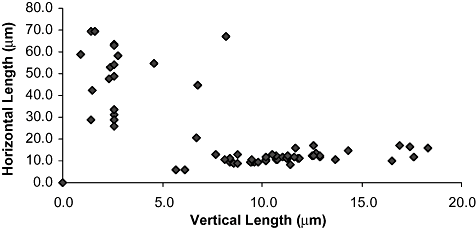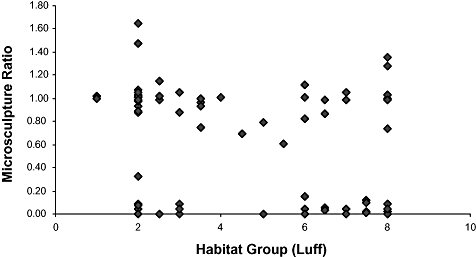Microsculpture in UK ground beetles: Are there patterns?
Abstract
Cuticular microsculpture “cells” were measured on 78 species of UK ground beetles. The data were analyzed to establish whether the type of microsculpture could be linked to ground beetle size (length) or ecological preferences. Larger species tended towards isodiametric patterns, while more of the smaller species showed a transverse or effaced pattern. There was no indication that preferences for dry or moist habitat were linked to microsculpture type, which had been suggested in the literature.
INTRODUCTION
Many beetle taxa are reported to show microsculpture on the cuticle (e.g. burying beetles (Hinton 1969), phalacrid beetles (Hinton & Gibbs 1969), gyrinid beetles (Hinton & Gibbs 1971) and dung beetles (Vulinec 1997)). Typically the microsculpture is visible on the elytra, but may also be found on other parts of the cuticle. This distinctive, albeit microscopic, feature of the cuticle leads to the appearance of iridescence. Beetles can assume a spectrum of different colors, depending on the direction of light and viewing angle.
The possible adaptive role of iridescence in beetles was considered by Lindroth (1974a) and Vulinec (1997). The range of explanations of the advantages of iridescence covered thermoregulation, water repellency, distracting glare (in relation to predators), crypsis and visual signaling (especially to conspecifics or predators). Despite a range of possible explanations, Lindroth noted that “The biological importance of iridescence is doubtful. . . . It seems that no generally valid selective value of diffraction grating can be applied and that, in many cases, it may be preserved only as ‘not harmful’.”
In this paper we will be referring primarily to ground beetles. Typically the predominant microsculpture lines are set at right angles to the long axis of the beetle body – with the exception of the genus Aephnidius (Hinton & Gibbs 1971). However, beyond that similarity, a number of different types of microsculpture have been described in different ground beetle species. The first paper to review this variation in ground beetles was by Lindroth (1974a), although general reference to microsculpture patterns was also made in his key to the British Carabidae (Lindroth 1974b).
Lindroth (1974a) identified four possible microsculpture types:
- •
Microsculpture absent.
- •
Reticulate microsculpture. In this category Lindroth included a range of mesh patterns, ranging from more-or-less isodiametric “cells” to “cells” which are transversely stretched and much wider than they are long (in relation to the main insect axis).
- •
Transverse microsculpture. Very stretched cells where the transverse lines linking the parallel transverse lines are almost absent. This is the closest pattern to a typical diffraction grating and, depending on the spacing of lines, can generate strong iridescence.
- •
Irregular microsculpture. A mix of reticulate and transverse in patches.
Lindroth (1974a) suggested that iridescent Carabidae are over-represented in moist habitats, especially the margins of open standing water. However, beyond such limited comments it is not clear that there are any rules that can be made about the taxonomy, morphology or ecology of ground beetles and their tendency to display particular types of microsculpture.
The aim of this study was to collect quantitative data on the form of microsculpture across a range of genera and species drawn from the United Kingdom ground beetle fauna. The intention was to determine whether patterns of microsculpture are essentially random in their distribution or whether there are any underlying environmental drivers determining what kinds of microsculpture appear in which species, as suggested by Lindroth (1974a).
MATERIALS AND METHODS
A total of 78 ground beetle species were examined from the first author's collection (J. D., see Appendix 1). In each case a single specimen was measured (chosen randomly where more than one was available), and a mix of male and female beetles included. Each was examined under a high power optical microscope with incident illumination through the objective (TIDAS Micro-Spectral Photometer 400 (J&M Analytische Mess-und Regeltechnik GmbH, Aalen, Germany) on a Zeiss Axioskop 2 MAT microscope (Carl Zeiss Ltd., Welwyn Garden City, UK)). The microscope was calibrated with an eyepiece graticule and stage micrometer. Single specimen beetles were measured for body length, using digital calipers, from the tip of the mandibles to the end of the elytra. Measurement of microsculpture was at a standardized position at the base of the elytra: within the first or second elytral striae, typically adjacent to the scutellar stria. With each specimen, 20 measurements were made of the vertical and horizontal axis of each “cell” and data are presented as mean values.
Data analysis involved calculating the ratio of vertical to horizontal measures of “cell” shape. A value close to one was an isodiametric shape, while values closer to zero were those species with strong transverse microsculpture.
Other data required for the analysis related to environmental preferences of different ground beetle species. The species found in the UK are generally well known and their environmental preferences have been reported by Luff (1998). The intention was to represent the environmental preferences of each beetle species by a single number. A scale was devised (see Table 1) which emphasized two aspects of the preferred environment: the nature and the extent of plant cover and moisture. The latter is often stressed as a factor of prime importance to many species (Luff 1998). The sequence of habitat types was arranged to allow 0.5 scores if beetle distribution related to two contiguous categories. For example, if a species was found in both “light herbaceous/grass cover” and “scrub/open tree cover” the score given for the species was 3.5. Where two non-contiguous category preferences were indicated, a score relating to the more important habitat was allocated (as indicated by Luff 1998).
| Habitat description | Score |
|---|---|
| Open ground. Dry soil. (xerophilous) | 1 |
| Sparse herbaceous/grass cover, including arable | 2 |
| Continuous herbaceous/grass cover | 3 |
| Shrub/open tree cover | 4 |
| Dry open woodland | 5 |
| Continuous herbaceous/grass cover (moist) | 6 |
| Full canopy moist woodland | 7 |
| Wetland vegetation/waterside. Wet soil (hygrophilous) | 8 |
RESULTS
The data were examined to look for pattern versus random distribution of microsculpture characters. Figure 1 is a scatterplot of horizontal versus vertical length of microsculpture “cells.” It is clear that there isn't a full spectrum of combinations of the two lengths: typically where there is horizontal extension then there is little change in vertical length, but there is also a range of species where the opposite is true. However, vertical extension was always less extreme than horizontal.

Mean microsculpture “cell” size (horizontal and vertical dimensions) for 68 UK ground beetle species.
Figure 2 shows the link between the vertical/horizontal ratio and beetle length. In general, the larger species are more likely to approach the isodiametric type of microsculpture while smaller species show either a strong transverse pattern or else microsculpture is absent (effaced). As would be expected from the data shown in Figure 1, there is clumping of species into two groups.

Mean microsculpture “cell” vertical/horizontal ratio in relation to species length. Plotted for 68 UK ground beetle species. Zero ratio values were not included.
Data on the link between microsculpture type and habitat type is shown in Figure 3. Again there is a strong indication that the distribution of data is not random. There is clumping of data points into four groups. There is no indication that beetles with no microsculpture (effaced) favor any particular habitat type.

Mean microsculpture “cell” vertical/horizontal ratio in relation to preferred habitat category. Plotted for 68 UK ground beetle species. Zero ratio values were not included.
DISCUSSION
The early work on microsculpture by Hinton and others in the 1970s provided no expectation of a link between particular biological/ecologic drivers and the appearance of specific microsculpture types in ground beetle species. The current data suggest that the size of the beetle influences the type of microsculpture: genera with larger beetles tend towards isodiametric rather than transverse microsculpture. In terms of selective advantage, the effect of different microsculpture “cell” shapes is likely to be indirect. It could be argued, for example, that larger iridescent species would be particularly visible to predators and so iridescence could be a negative feature. However as most species are only active at night this is a difficult argument to sustain. Hinton and Gibbs (1969) reported that in species which are potentially very visible (phalacrid flower-feeding beetles) there is an increase in iridescence in tropical environments where sunshine is likely to make iridescence even more prominent. Even in the UK there are diurnal species, such as Notiophilus biguttatus (Fabricius), which are iridescent and often very visible on open ground (Luff 1998). In addition, the lack of transverse microsculpture did not necessarily equate with lack of iridescence: for example, species of the genus Amara are relatively large, isodiametric and often strongly iridescent.
Another thought about the adaptive value of microsculpture patterns relates to the “roughness” of the cuticle surface and the ability of beetle species to push their way through a substrate. It seems probable that this would be a more important factor for small beetle species. Baehr (1979, cited in Forsythe 2000) suggested that Clivina and Dyschirius ground beetles which burrow into the substrate have the advantage of a highly polished cuticle with no microsculpture. However, lack of microsculpture is also seen in Notiophilus biguttatus, which spends much of its time actively hunting on the soil surface. Taking the argument further is difficult because it is unclear whether transverse or isodiametric microsculpture generate significantly different frictional properties. Hence there is no rationale for the association of smaller ground beetle genera with transverse microsculpture.
A second aspect of this study related to microsculpture, species and habitat preferences. Very broadly speaking, the range of beetles studied had a preference for either relatively dry or relatively wet/moist vegetation (note the dichotomy in Fig. 3). There was little indication that habitat preference was reflected in microsculpture ratios, which were all similarly represented in both habitats. If, as noted by Lindroth (1974a), that iridescence is more common amongst species of moist habitats then there was no evidence that this is linked to any particular pattern of microsculpture.
To conclude, it seems that there may be some pattern in the distribution of microsculpture type among UK ground beetles, but there is no indication that microsculpture is adaptive in response to habitat differences.
Appendix
APPENDIX 1
Species used for microsculpture studies. Full details of measurements available from the corresponding author.
Acupalpus meridianus Linnaeus, Agonum albipes Fabricius, Agonum dorsale Pontoppidan, Agonum marginatum Linnaeus, Agonum moestum Duftschmid, Agonum muelleri Herbst, Agonum obscurum Herbst, Amara aenea De Geer, Amara familiaris Duftschmid, Amara apricaria Paykull, Amara aulica Panzer, Amara bifrons Gyllenhal, Amara communis Panzer, Amara eurynota Panzer, Amara lunicollis Schiødte, Amara plebeja Gyllenhal, Amara praetermissa C. R. Sahlberg, Amara similata Gyllenhal, Anisodactylus binotatus Fabricius, Asaphidion flavipes Linnaeus, Badister bipustulatus Fabricius, Bembidion assimile Gyllenhal, Bembidion guttula Fabricius, Bembidion articulatum Panzer, Bembidion genei Küster, Bembidion harpaloides Serville, Bembidion lampros Herbst, Bembidion lunulatum Geoffrey-Fourcoy, Bembidion obtusum Serville, Bembidion quadrimaculatum Linnaeus, Bembidion tetracolum Say, Bembidion unicolor Chaudoir, Bembidion varium Olivier, Calathus mollis Marsham, Calathus ambiguus Paykull, Calathus melanocephalus Linnaeus, Calathus piceus Marsham, Chlaenius nigricornis Fabricius, Chlaenius vestitus Paykull, Clivina fossor Linnaeus, Demestrias atricapillus Linnaeus, Dicheirotrichus gustavi Crotch, Dromius agilis Fabricius, Dromius linearis Olivier, Dromius melanocephalus Dejean, Dyschyrius luedersi H. Wagner, Elaphrus cupreus Duftschmid, Elaphrus riparius Linnaeus, Harpalus aeneus Fabricius, Harpalus anxius Duftschmid, Harpalus ardiosacus Lutshnik, Harpalus rufibarbis Fabricius, Harpalus tardus Panzer, Harpalus schaubergianus Puel, Leistus ferrugineus Linnaeus, Leistus fulvibarbis Dejean, Leistus rufescens Fabricius, Leistus rufomarginatus Duftschmid, Leistus spinibarbis Fabricius, Loricera pilicornis Fabricius, Metabletus truncatellus Linnaeus, Nebria salina Fairmaire, Notiophilus aquaticus Linnaeus, Notiophilus biguttatus Fabricius, Notiophilus palustris Duftschmid, Notiophilus aestuans Motschulsky, Notiophilus rufipes Curtis, Olisthopus rotundatus Paykull, Platyderus ruficollis Marsham, Pterostichus angustatus Duftschmid, Pterostichus cupreus Linnaeus, Pterostichus nigrita Paykull, Pterostichus strenuus Panzer, Stenolophus mixtus Herbst, Synuchus nivalis Panzer, Trechus secalis Paykull, Trechus micros Herbst, Trechus obtusus Erichson.




